#libraryofmoths
Text
Moth of the Week
Spanish Moon Moth
Graellsia isabellae
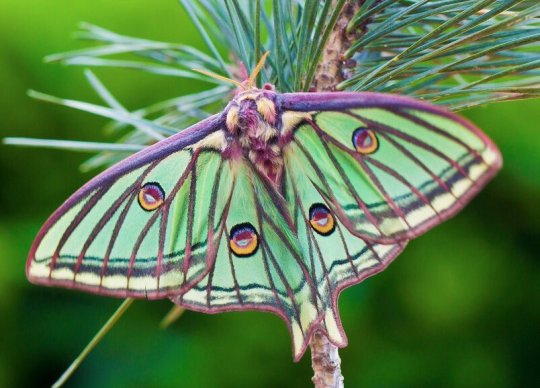
The Spanish moon moth was first described in 1849 by Mariano de la Paz Graells y de la Agüera as Actias isabellae. However it was moved to the genus Graellsia, which was created in 1896 by Augustus Radcliffe Grote. It is part of the moth family Saturniidae and often associated with other “moon moths” under Actias although this species split off years ago. It is the only species in Graellsia and has no subspecies, making it a monotypic genus.
Description This moth has green wings with reddish-brown lines and yellow-green hindwing tails. These lines border all four wings and trace over the moth’s veins. The lower edges of both the hindwings and forewings (called the outer margins) are lined with black and the same yellow-green as the tails. This yellow-green is also seen on the forewings close by the moth’s head and on the hindwings in a gradient. Each wing has a magenta, orange, white, and black eyespot in between its veins with the hindwing spots being larger.
The body is yellow-green as well with reddish brown patterning. The antennae can be dark or orangish-brown.
The males have longer tails and bushier antennae while females have stubby tails and larger bodies.
Wingspan Range: 6.35 – 10.16 cm (2.5 - 4 in)
Diet and Habitat The caterpillar of this species eats pine needles, specifically from the Pinus nigra (Austrian Pine) and Pinus sylvestris (Scots Pine), which are native to its habitat. Interestingly, this species doesn’t easlily adapt to eating non-native pine species even if they are from the same genus.
This species is native to Spain and France but is also found in Switzerland. They live in the Alps and the Pyrenees mountains, which are considered a “refugee location.” Due to the cool, dry, and unchanging climate the Spanish moon moth has been able to remain unchanged for thousands of years. It is also a protected species.
Mating Adult moths hatch at the end of April to early May. The females lays 100 to 159 eggs, using pines as host plants. The eggs hatch after 1 to 1.5 weeks. It is important to note that adult from the same family will not mate with each other.
Predators Presumably, this moth uses its eyespots to imitate a larger animal and scare away predators.
Fun Fact A hybrid moth species was created by breeding the Spanish moon moth and the Indian moon moth (Actias Selene).
(Source: Wikipedia, Moth Identification, The Butterfly Babe)
#libraryofmoths#animals#bugs#facts#insects#moth#mothoftheweek#lepidoptera#Saturniidae#spanish moon moth#Graellsia isabellae
412 notes
·
View notes
Text
Moth of the Week
Kentish Glory
Endromis versicolora

The Kentish glory was first described in 1758 by Carl Linnaeus. It is a part of the family Endromidae which was created in 1810 by Ferdinand Ochsenheimer. This is a monotypic genus, meaning there is only one species in it being the Kentish glory.
Description The male and female of this species are clearly told apart by their colors and size.
Males are darker and more orange than females with feathery antennae
Males hindwings are orange
Females are paler/more washed out in color and larger to carry eggs
The forewings of this moth are a marbled black, orange, and white. The outer edge of the wing called the outer margin is brown with white stripes along the veins. The females hindwings are the same marbled black, brown, and white with a brown edge. The males hindwings are orange with brown markings.
The legs and antennae are black while the thorax is brown and white. The females abdomen is black while the males abdomen is a similar orange to the hindwing.
Sources differ on wingspan range.
Wikipedia: 50 - 70 mm (≈1.97 - 2.76 in)
Butterfly Conservation: Male 27 - 30 mm (≈1.06 - 1.18 in), Female 34 - 39 mm (≈1.34 - 1.54 in)
Diet and Habitat The larvae of this species eats mainly birch (Betula species) but will eat other trees and shrubs such as Alnus, Corylus, Tilia and Carpinus species. Adults do not feed.
This moth’s range used to be much larger, such as living in the southern and western English counties of Kent, Sussex, Berkshire, East Anglia, Herefordshire, and Worcestershire and the southeastern Welsh county of Monmouthsire.
Now this moth is restricted to living in the central and eastern Highlands of Scotland. It is seen in the Scottish counties of Perthshire, Inverness-shire, Morayshire, Aberdeenshire and Kincardineshire.
They prefer to inhabit open birch woodland and lightly wooded moorland.
Mating Females use pheromones to attract males, who can detect them from 1-2 km (≈0.62 - 1.24 mi) away.
This species has one single generation per year. The females lay their eggs, which are yellow at first then purplish-brown, in batches of 10-20 eggs on low birch scrub at an average height of 1.2m (≈1.31 yd). They prefer to let them on sheltered, unshaded saplings, usually the first few batches are near where the females emerged. The eggs hatch after 10 to 14 days.
Predators Males usually fly during the day from mid morning to early afternoon while females fly at dusk. Because of this males are presumably preyed on by daytime birds while females are preyed on by bats.
Fun Fact The females do not fly as strong as males due to the eggs they carry as it weighs them down. Females tend to lay their first few batches of eggs close to where they emerged due to this fact.
(Source: Butterfly Conservation, Wikipedia, Rothiemurchus)
#libraryofmoths#animals#bugs#facts#insects#moth#mothoftheweek#lepidoptera#kentish glory#Endromis versicolora#Endromidae
266 notes
·
View notes
Text
Moth of the Week
Salt Marsh Moth
Estigmene acrea
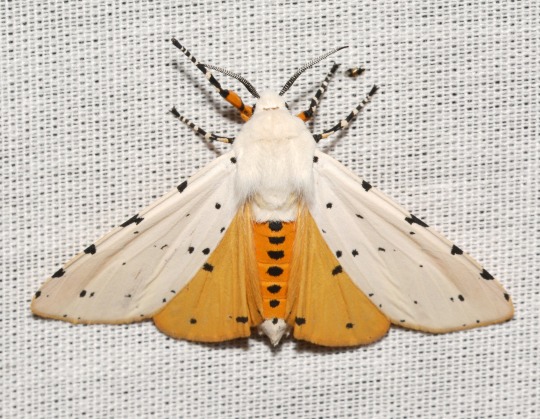
The salt marsh moth is a part of the family Erebidae. This species was first described in 1773 by Dru Drury. It is also known as the acrea moth.
Description Both male and female moths have white heads, thoraxes, and forewings with a varying pattern of black spots on the forewings, with some moths having no pattern at all. They also share an orange-yellow abdomen with a vertical line of back dots. On the male, the hindwings are the same organge yellow while on females the hindwings are white. Both males and females have three or four black dots on each hindwing.
Wingspan Range: 4.5 - 6.8 cm (≈1.77 - 2.68 in)
Diet and Habitat The caterpillar was first thought to be a pest to salt-grass, but in fact it prefers weeds, vegetables, and field crops such as dandelions, cabbage, cotton, walnuts, apple, tobacco, pea, potato, clovers, and maize. Adults do not feed.
This moth is found in North America, the Democratic Republic of the Congo, Kenya, Colombia, and Mexico. It prefers open habitats such as openings in woods, thickets, farm fields, grasslands, and marshes. It is called the “salt marsh moth” because it is common in coastal salt marshes (tidal marshes) along Pacific, Atlantic, and Gulf coasts.
Mating This species of moth does not emit pheromones from the tip of its abdomen but instead from its throat or the to of its abdomen. These moths are seen from May to August but can be seen all year in southern Florida and Texas. It is presumably during May and August they mate in most parts of their range while they mate all year round in Florida and Texas.
Yellowish eggs are laid in clusters on the host plant leaves. Females usually produce 400 to 1000 eggs in one or more clusters. It is possible to find a single egg cluster containing 1200 eggs. Eggs hatch in four to five days.
Predators This species is frequently parasitized as larvae, usually by flies in the Tachinidae family. In Arizona, the most common parasites were Exorista mellea and Leschenaultia adusta while two other parasitic flies were also seen: Gymnocarcelia ricinorum and Lespesia archippivora.
Both the larval and egg stages are oararzitized by Hymenopteran parasitoids such as Apanteles diacrisiae; Therion fuscipenne, T. morio, Casinaria genuina, Hyposoter rivalis; Psychophagus omnivorus, Tritneptis hemerocampae Vierick; Anastatus reduvii; and Trichogramma semifumatum.
A cytoplasmic polyhedrosis virus is known to harm this species but there are little data on its importance and effect.
General predators such as lady beetles, softwinged flower beetles, and assassin bugs prey on these caterpillars, but are not thought to have a large impact on population.
Fun Fact This species has 4 subspecies: Estigmene acrea acrea, Estigmene acrea arizonensis (Rothschild, (1910)) (Arizona), Estigmene acrea mexicana (Walker, (1865)) (Mexico), Estigmene acrea columbiana (Rothschild, (1910)) (Colombia).
(Source: Wikipedia, University of Florida, Missouri Department of Conservation)
#libraryofmoths#animals#bugs#facts#insects#moth#lepidoptera#mothoftheweek#Erebidae#salt marsh moth#Estigmene acrea
391 notes
·
View notes
Text
Moth of the Week
Antler Moth
Cerapteryx graminis
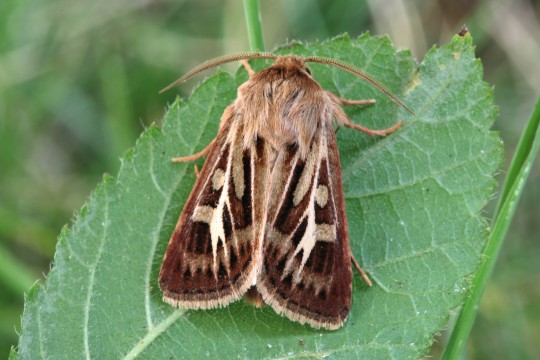
The antler moth is a part of the family Noctuidae. It was first described in 1758 by Carl Linnaeus. This moth gets its name from the antler shaped mark in its forewings.
Description This moth species has brown forewings, with a “basal streak” of white that branches out. This mark may vary in size per moth. The forewings show a mirrored pattern of the base brown broken up by the branches and a few spots and lines of lighter brown. The forewing also may or may not have black streaks. The hindwing is dark brown with a white fringe.
Males are smaller than females with fluffier antennae.
Male Wingspan: 27 - 32mm (≈1.06 - 1.26in)
Female Wingspan: 35 - 39mm (≈1.38 - 1.53in)
Diet and Habitat The larva of this species feeds on grasses such as Deschampsia, Sheep’s-fescue (Festuca ovina), Mat-grass (Nardus stricta) and Purple Moor-grass (Molinia caerulea). It has also been found on sedges and rushes. When the larva population is concentrated enough, they can damage pastures. Adults feed on flowers such as thistles and ragworts.
This species is common through most of Europe. It’s northernmost reach is Iceland and above the Arctic Circle. It’s easternmost reach is Siberia and North Mongolia. This moth does not occur in the dry southern regions of Europe. It has been introduced to North America. Additionally, this species inhabits the Alps. They prefer habitats of grassland, favouring acid upland pasture, moorland and downland.
Mating Adult moths are seen flying from July to September. They presumably mate in this time frame.
Predators This moth flies during the day, especially in the north, warm weather, and early mornings, and at night. They are presumably preyed on by both daytime and night time predators like birds and bats. They are attracted to light. To protect themselves during the day, this moth hides in the grass.
Fun Fact The antler moth rises to an altitude of 2100 meters in the Alps.
(Source: Wikipedia, Butterfly Conservation)
#libraryofmoths#animals#bugs#facts#insects#moth#lepidoptera#mothoftheweek#antler moth#Noctuidae#Cerapteryx graminis
196 notes
·
View notes
Text
Moth of the Week
Canary-shouldered Thorn
Ennomos alniaria
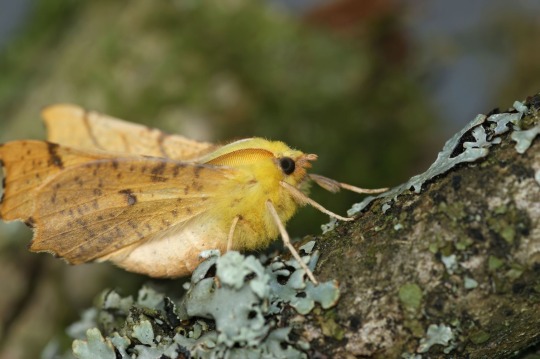
The canary-shouldered thorn was first described in 1758 by Carl Linnaeus. It is a part of the family Geometridae. This moth gets its name from its bright yellow coloring.
Description This moth has a bright canary yellow head and thorax. The forewings and hindwings are a ochre yellow with gray speckles. Both the forewings and the hindwings are a scalloped shape and both have a single dot on each wing called “discal spots” with the spots being larger on the hindwing. The forewings have two curved lines going across them.
This moth looks very similar to the Dusky Thorn, August Thorn and September Thorn moths.
Wingspan Range: 34 - 42 mm (≈1.34 - 1.65 in)
Forewing Range: 16 - 20 mm (≈0.63 - 0.79 in)
Diet and Habitat The larva of this species feed off of deciduous trees such as downy birch, silver birch, alder, goat willow, elms, and limes.
This moth’s range stretches from Russia and the Caucuses region in the east to Western Europe in the west and from Fennoscandia in the north to the northern Mediterranean in the south. It has also been introduced into British Columbia. The prefer habitats of woodland, scrub, parks and rural gardens.
Mating This moth has one generation per year. They can be seen flying from July and October and presumably mate during this time.
Predators This species is nocturnal and presumably majorly preyed on my nighttime predators such as bats. However it does use a form a camouflage as larva. The caterpillars of this species resemble dead twigs. This may also help against daytime predators.
Fun Fact The canary-shouldered thorn is attracted to light.
(Source: Wikipedia, Butterfly Conservation, Moths of Britain)
#libraryofmoths#animals#bugs#facts#insects#lepidoptera#moth#mothoftheweek#canary-shouldered thorn#Ennomos alniaria#Geometridae
158 notes
·
View notes
Text
Moth of the Week
Hornet Moth
Sesia apiformis
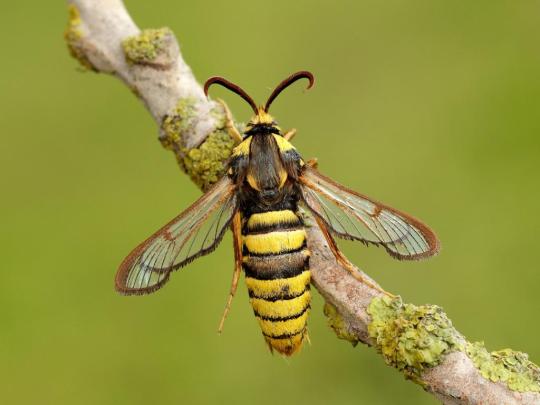
The hornet moth is a part of the family Sesiidae or the family of clearwing moths. They get their common name predictably from how they mimic the appearance of the hornet. This type of mimicry is called Batesian mimicry, which is when a harmless species mimics the appearance of a unpalatable or defended species to protect themselves from predators. It was first described in 1759 by Carl Alexander Clerck under the name Sphinx apiformis.
Description This moth uses what called Batesian mimicry to resemble the hornet so predators do not want to eat it for fear of being stung. The adult moths have clear wings with yellow and striped black bodies. The number of stripes varies, females have two stripes while males have three. They are about the size of a hornet with the same jerky flight pattern when disturbed. The only difference is the hornet moth has more yellow and lacks the waist between the abdomen and the thorax.
Wingspan Range: 34 - 50 mm (≈1.34 - 1.97 in)
Females are larger than males
Diet and Habitat The larvae eat several species of poplar trees such as apsen (Populus tremula), black poplar (Populus nigra), and goat willow (Salix caprea). They prefer trees surrounded by heavy vegetation as those kinds show more evidence of infestation from larvae burrowing into trees. Adults do not eat.
This moth ranges over mainland Europe, Great Britain, and parts of the Middle East. It had also been introduced to America and Canada. They prefer open habitats such as parks, hedgerows, golf courses, quarries, fens, pond edges, and pits.
Mating The female moths attract males using special posterior glands to emit pheromones, usually soon after emergence. The male doesn’t seem to have any courtship behaviors as the two sexes are likely to begin mating as soon as they come into contact. Both males and females mate multiple times with different partners before the female beings laying her eggs.
Females prefer to lay eggs on old or isolated trees surrounded by vegetation. Females can lay from hundreds to thousands of eggs and exhibits no parental care. When comparing the number of eggs laid to the number of adults emerging per year, it is clear the large number of eggs laid is to make up for the large mortality rate between the egg and adult stages.
Predators This species of moth is primarily preyed on by magpies and great tits. Interestingly, these birds do not eat hornets despite eating this moth. An explanation for this is since these birds don’t eat hornets, the mimicry is less effective as they have any bad experiences with insects of this coloration. In fact, it can be suggested that the black and yellow coloration has the opposite effect: once the birds realize this moth is harmless and can be easily seen, they begin to actively seek them out.
Fun Fact The hornet moth is seen as a pest in the eastern United Kingdom due to a large dieback of poplar trees from larvae burrowing into them. However this dieback is not inherently caused by the larvae but instead from drought and human influences, which the larvae increase the effect of.
(Source: Wikipedia, Butterfly Conservation)
#libraryofmoths#animals#bugs#facts#insects#moth#mothoftheweek#hornet moth#Sesia apiformis#Sesiidae#lepidoptera
221 notes
·
View notes
Text
Moth of the Week
Macrocilix maia Moth
Macrocilix maia
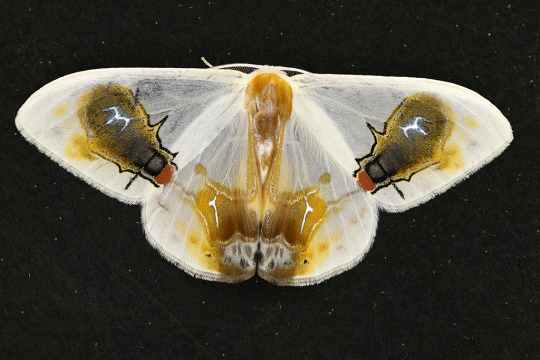
The Macrocilix maia moth is a part of the family Drepanidae. It was first described in 1888 by John Henry Leech as a part of the genus Argyri. It has no recognized common name and is mainly called by its scientific name.
Description
The forewings and hindwings are a matching cream color and slightly translucent. The main attraction of the wings are two mirror images of a fly, one on each forewing. The body of the “fly” is black with red eyes/head and a white accent in the middle of its abdomen. They are outlined in amber and black with amber specks on the outer edge of the forewing called the outer margin. The hindwings have an amber splotch on the innermost edge, called the inner margin, that transitions to black and white as it reaches the corner. This is meant to look like a bird dropping that the flies are eating.
The body is a matching amber/dark brown as the bird dropping to blend in. The antennae are cream.
Wingspan Range: 3.7 - 4.5 cm (≈1.46 - 1.77 in)
Diet and Habitat This moth mainly, feeds on the Chinese Cork Oak as larva and do not feed as adults.
They are found around Asia in Borneo, China, India, Japan, Korea, Peninsular Malaysia, Sumatra, and Taiwan. This moth prefers habitats like forests and jungles.
Mating The eggs are laid close to the host plant and adults are emerge in May. Mating season is presumably around this time.
Predators This moth is most recognizable by its use of mimicry. It’s wings resemble flies eating bird droppings to make it appear unappealing to predators. It also gives off a bad smell to further sell the act.
Fun Fact The type of camouflage this moths uses is called Batesian mimicry. Named after Henry Walter Bates, Batesian mimicry is when a palatable animal, or one without toxins or poison, evolves to look like an unpalatable/undesirable animal to protect itself from predators.
(Source: Wikipedia, Moth Identification)
#libraryofmoths#animals#bugs#facts#insects#moth#mothoftheweek#lepidoptera#Macrocilix maia#Macrocilix maia moth#Drepanidae
219 notes
·
View notes
Text
Moth of the Week
Bird-Cherry Ermine
Yponomeuta evonymella

Image source
The bird-cherry ermine is a part of the family Yponomeutidae, the ermine moths. It was first described in 1758 by Carl Linnaeus. It was originally placed in the genus Phalaena but was later transferred to the genus Yponomeuta, becoming Yponomeuta evonymella. This species’ common name comes from their main food plant: Bird Cherry.
Description This moth has a white thorax, head, and forewings. The forewings have five horizontal lines of small black dots, and a few black dots are also on the back of the thorax. The hindwings are shorter and wider than the forewings and are a beige/light brown color. Both the forewings and hindwings have a fringe on the end however, the forewings’ white fringe is short and only on the outer margin while the hindwings’ brown fringe is all over the hindwings’ edges besides the parts touching the forewings. Additionally the hindwings’ fringe is longer on the bottom of the wing. This moth’s thin and wiry antennae are two thirds the length of the forewing and are usually white.
Wingspan Range: 16 - 25 mm (≈0.63 - 0.98 in)
Diet and Habitat This species’ caterpillars mainly feeds on Bird Cherry (Prunus padus), but they also occasionally feed on cherry (Prunus) or buckthorn (Rhamnus). They are known to sometimes be pests of the bird-cheery because the caterpillars pupate and feed together in web like nests that can cover whole trees. This web keeps them protected and allows them to eat mostly unbothered by other insects and predators. The tree is still likely to survive after this, but may grow less in the following growth season/spring. Adults feed on nectar.
This species can be found in Europe and the northern and eastern parts of Asia. They live in many habitats such as river lowlands, deciduous forests, alluvial forests, stream banks with bushes and trees, gardens, parks, and more. Strangely according to Butterfly Conservation, this moth can be found “often far from the known foodplant.”
Mating This moth is seen in June to September and has only gerarion per year. Females let their eggs on the winter buds of their food plants.
Population sizes fluctuate, but it’s not uncommon for mass outbreaks of caterpillars to happen, which results in defoliated trees.
Predators This species is preyed on by parasitic wasps and seems to have few other predators.
Fun Fact This moth is attracted to light. Additionally when disturbed, this moth can skip away and falls to the ground. Note: this second fact does not currently have a citation on Wikipedia so it may be disproven in the future.
(Source: Wikipedia, Butterfly Conservation)
#libraryofmoths#animals#bugs#facts#insects#moth#lepidoptera#mothoftheweek#Yponomeuta evonymella#bird-cherry ermine#Yponomeuta
105 notes
·
View notes
Text
Moth of the Week
Drinker
Euthrix potatoria
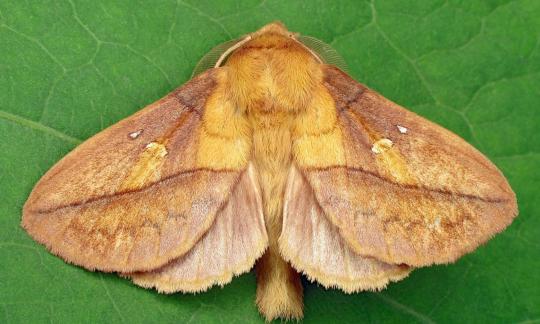
The drinker moth is of the family Lasiocampidae. It was described and named in 1758 by Carl Linneaus. Linneaus chose the species name potatoria as it means ‘drinker-like.’ Dutch entomologist Johannes Goedaert had previously called the moth dronckaerdt, meaning ‘drunkard,’ “because it is very much inclined to drinking” or because this moth repeatedly puts its head into water. The common name ‘drinker’ comes from the same reason.
Description This moth is distinguishable from other eggar moths by a diagonal line crossing the forewing and two white spots also on the forewing. Males are usually reddish or orangish-brown with yellow patches. Males in East Anglia are often yellowish. Females can be yellow, a pale buff, whitish, or a darker reddish-brown than the males. Male and females also differ in size and antennae shape: females are slight larger than males, and males have fluffier antennae.
Wingspan Range of Fully Grown Drinker: 45–65 mm (≈1.77 - 2.56 in)
Diet and Habitat The caterpillars of this species feed on grasses and reeds in genuses such as Alopecurus, Deschampsia, Dactylis, Elytrigia, Carex, Luzula, and other Gramineae. A few examples are Cat grass (Dactylis glomeratus), Common Reed (Phragmites australis), Reed Canary-grass (Phalaris arundinacea), and Wood Small-reed (Calamagrostis epigejos).
In the spring, they feed mainly at night and can be found resting on low vegetation during the day. The larva also supposedly drink morning dew because it had been observed to repeatedly put its head in water.
This moth can be found in Europe. It is common throughout England and Ireland but tends to favor western Scotland over eastern Scotland. It prefers habitats of marshy places such as fens, riversides, tall and damp grassland, marshes, damp open woodland, scrub, and ditches. However this species does sometimes live in drier habitats such as grassy terrain and urban gardens.
Mating Adults can been seen between July and August and presumably mate during this time. There is only one generation per year. Eggs are laid mainly on the stems of grasses or reeds in small clusters.
Predators Adult moths fly at night and are presumably preyed on by nocturnal predators such as bats.
Fun Fact Both sexes of the drinker moth are attracted to light, but males are especially susceptible.
(Source: Wikipedia, Butterfly Conservation)
#Euthrix potatoria#drinker#drinker moth#Lasiocampidae#libraryofmoths#facts#insects#mothoftheweek#animals#bugs#moth#lepidoptera#happy new years!#sorry for not posting
88 notes
·
View notes
Text
Moth of the Week
African Death’s-Head Hawkmoth
Acherontia atropos

The African death's-head hawkmoth is part of the family Sphingidae and is the most widely recognized of the three species of Death’s-Head Hawkmoth. The species was described in 1758 by Carl Linnaeus. Its common name comes from the skull shape on the back of its thorax. It’s binomial name: comes from the river Acheron in Greece, which was believed to lead to the Underworld, and the Greek goddess Atropos respectively.
Description The forewings are black/brown with mottled shades of brown while the hindwings are buff orange with two black/brown stripes that curve with the edge of the hindwing. The head and thorax are the same black/brown color as the forewings interrupted by the brown skull on the back of the thorax. The abdomen is the same buff color as the hindwings with similar stripes of the same color. There is also a single stripe down the center of the abdomen called the “dorsal stripe.”
Average Wingspan: 13 cm (5 in)
Females are large than males with a rounded abdomen tip and larger, thicker antennae
Males have a pointed abdomen tip
Diet and Habitat Larva of this species mainly eat the leaves of potato plants which have alkaloids. The larva accumulate these toxins to become unpalatable to predators. Adults eat the nectar of flowers and stolen honey from the beehives of the Western Honey Bee. They are able to mimic the scent of bees and steal the honey undetected. They use their proboscis, a tube used to drink nectar and honey, to break the honey comb.
Their ranges stretches from the Middle East, as far south as the southern tip of Africa, as far north as southern Great Britain, as far east as India and western Saudi Arabia, and as far west as the Canary Islands and Azores. It is known to move into western Eurasia, but a majority do not survive the winter.
Mating This moth has multiple generations per year. In Africa, the broods are continuous. In the northern range, the larva overwinter in the pupal stage. Eggs are laid singly on the underside of species in mainly Solanaceae but also Physalis, Verbenaceae, Cannabaceae, Oleaceae, Pedaliaceae and others.
Predators This moth can emit a special squeak noise by sucking in air to vibrate a flap in its mouth and throat. The purpose of this squeak is unclear, but the two hypotheses are it is to scare away predators or to mimic the sound of a queen bee makes for the workers to stop moving to easier raid beehives for honey. They are also immune to bee venom and can mimic the scent of bees.
Fun Fact This moth has appeared many times in pop culture as symbols of death and evil:
It appeared in The Hireling Shepherd, Bram Stoker's Dracula, Un Chien Andalou, the promotional marquee posters for The Silence of the Lambs, in the music video to Massive Attack's single, "Butterfly Caught,” and on the American edition's cover of José Saramago's novel Death with Interruptions.
It is mentioned in Susan Hill's Gothic horror novel I'm the King of the Castle and John Keats’s "Ode to Melancholy.”
It is referred to in The Mothman Prophecies.
Finally, the moth is used as a calling card by the serial killer Buffalo Bill. However, in the movie script they are referred to under a different species of death’s-head hawkmoths.
(Source: Wikipedia, Simple English Wikipedia)
#libraryofmoths#animals#bugs#facts#insects#moth#mothoftheweek#lepidoptera#Sphingidae#African death’s-head hawkmoth#Acherontia atropos
161 notes
·
View notes
Text
Moth of the Week
Dew Moth
Setina irrorella

Photo credit
The dew moth is a part of the family Erebidae. It was first described in 1758 by Carl Linnaeus. It is thought to have gotten its common name from how the moth hangs from a blade of grass or a leaf when resting during the day. This gives it a transparent look.
Description This species’s wings can vary in colour from cream to yellow. The forewing has 3 lines of black dots across it with the hindwing usually having only one black dot. The underside of the forewing is gray with a yellow margin. The body is black with yellow or black legs.
There are many found variations of this moth:
signata Borkh. - the middle rows of spots are connected by streaks
ab. fumosa Sandb. - has brownish ground colour; found in the north, but also found in Germany.
flavicans Bdv. - has brighter deep yellow wings and the apex of the abdomen is yellow; found in the Mediterranean and Anterior Asia.
nickerli Rebel - paler yellow, the forewing slightly dulled with the exception of the clearer yellow inner margin; found in the Alps and Northern Europe.
andereggi H.-Schiff. - has dark veins on the forewings, appearing like rays; found in the high Alps, and in the higher North.
riffelensis Fall. - considerably smaller, the ground colour is slightly dulled, the black vein-streaks are more numerous, especially the costa and median veins strongly sooty black; found in the high Alps, especially abundant above Zermatt.
lata Christ. - larger with broader wings and paler with very few markings, the hindwing often quite without markings; found in Russia over North Siberia to Kamtschatka.
insignata Stgr., - quite similar to the preceding, but with narrower wings. The forewing also with very few dots, and hindwing without any; found in East Siberia.
Wingspan Range: 27 – 33 mm (≈1.06 - 1.30 in)
Forewing Range: 11 – 18 mm (≈0.43 - 0.71 in)
Diet and Habitat The larva of this moth eat only lichen.
This moth is found in the Palearctic region. Its range starts from Ireland, then spreads south through Europe and east to northern and Central Asia. It can be found in countries such as Siberia, Kamchatka, Chukotka, and northern Mongolia. This species can even live in the limestone Alps up to 2,000 meters above sea level. However, it can not be found in the high north and parts of the Mediterranean region.
It prefers to live in mossy and lichen-covered rock corridors, on chalky and sandy areas and steep, rocky sparse grasslands, rocky coasts, shingle beaches, and calcareous grassland inland. It can also be found in bogs, forest meadows, and on heaths.
Mating Depending on location, this moth can be seen from May to July. It presumably mates during this time. Generations per year not listed.
Predators Not listed. However, the adult males fly in the afternoon, at dusk, after dark, and at dawn. The females are largely nocturnal. These moths are presumably preyed on by nighttime predators such as bats.
Fun Fact The dew moth has four subspecies:
Setina irrorella irrorella
Setina irrorella freyeri (Nickerl, 1845)
Setina irrorella insignata (Staudinger, 1881)
Setina irrorella mediterranea (Daniel, 1964)
Additionally, dew moth caterpillars do not cocoon in trees or foliage but rather in between stones or rocks.
(Source: Wikipedia, Butterfly Conservation)
#libraryofmoths#animals#bugs#facts#insects#moth#lepidoptera#mothoftheweek#Setina irrorella#dew moth#Erebidae
78 notes
·
View notes
Text
Moth of the Week
Buff-Tip
Phalera bucephala
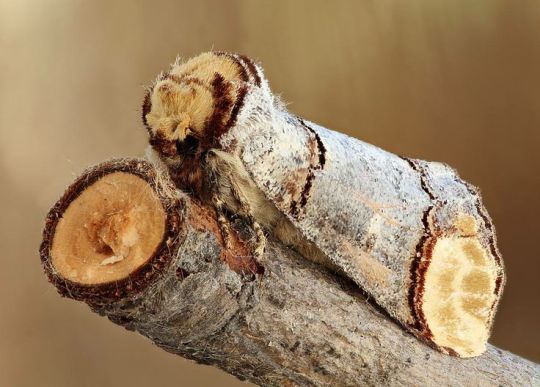
The buff-tip is part of the family Notodontidae and was first described in 1758 by Carl Linnaeus. They are best know for their resemblance of a broken birch twig when at rest. The name buff-tip comes from the color on the head and edge of the wings, buff: “a light brownish yellow, ochreous colour, typical of buff leather.”
Description The body is hairy, with a buff colored patch on the head followed by a brown ring. The upper body visible from under the wings is a mottled gray to match the forewings. The rest of the body is covered when resting and is a cream white with gray, cream and or brown legs. The forewings are also mottled gray with brown patterning and a buff patch at the tip mirrored on both sides. The hindwings are the same cream as the lower body. The antennae are brown and hidden when camouflaged.
Average wingspan: 55-68 mm
Males are smaller than females
Diet and Habitat Common food plants for this moth include the Norway maple, birch, chestnut, hazel, oak and many more. Caterpillars are social as young larva and eat in groups which can cause the defoliation of their host plants. Adult moths do not feed.
This moth is found across Europe and in Asia to eastern Siberia. It is very common in the British Isles, more so in the south than in the north. They prefer habitats with deciduous trees like open woodlands, scrubs, hedgerows, and urban gardens.
Mating Generally, the buff-tip can be seen from May to July, which is most likely their mating season. This moth is strictly nocturnal so it is also most likely they mate during the night. They have one generation per year with the females laying the eggs in clusters on the underside of leaves. The young larva are sociable and grow to be solitary through 4 instars.
Predators In order to protect itself while resting during the day, this species has adapted to look like a broken birch twig. This deceives common day time predators of moths such as birds and lizards.
Fun Fact This moth has been considered a pest in Lithuania for eating apple trees in the 1900s. High levels of environmental nitrogen compounds can increase outbreaks of the buff-tip.
(Source: Wikipedia, Wildlife Insight, London Wildlife Trust, Butterfly Conservation)
#libraryofmoths#animals#bugs#facts#insects#moth#mothoftheweek#lepidoptera#Notodontidae#buff-tip#Phalera bucephala
192 notes
·
View notes
Text
Moth of the Week
Chimney Sweeper
Odezia atrata
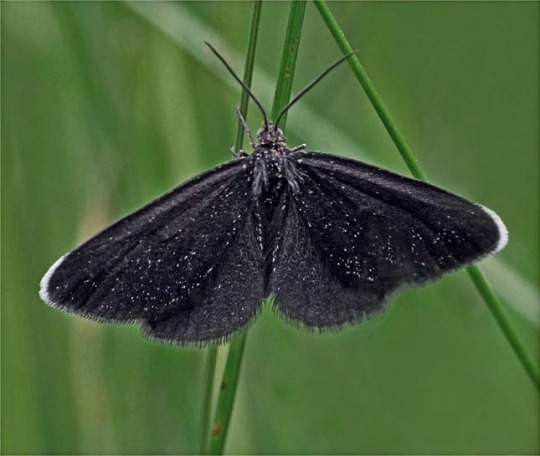
The chimney sweeper is a part of the family Geometridae. It belongs to a monotypic genus, meaning it’s the only moth species in the genus Odezia, which was created in 1840 by Jean Baptiste Boisduval. It was first described in 1758 by Carl Linnaeus.
Description This moth is mostly black with white on the tips of the forewing (called the “apex”) and on the fringe of the forewing.
There have been a few variations in color:
- Odezia atrata pyrenaica, which is found in Pyrenees and central Italy, the wings are “dusted” in a brownish yellow with a stronger color on the forewing.
- Ab. Odezia atrata nigerrima, described by Paul Thierry-Mieg, was a female with no white apex or fringe.
- This moth’s wings may become brown from wear over time.
Wingspan Range: 23–27 mm (≈0.91 - 1.06 in)
Forewing Range: 12–15 mm (≈0.47 - 0.59 in)
Diet and Habitat The caterpillars of this species mainly eats the flowers and seeds of pignut (Conopodium majus).
This moth is distributed in the Palearctic region. In the west, it’s range reaches the Iberian Peninsula through western and central Europe and the British Isles. In the east, they can be found in Sakhalin and the Amur-Ussuri region. I’m the north, this moth reaches central Fennoscandia. Finally, in the south they are found in Italy to the Balkans.
These moths were once very common in Austria, but now the species is a rare occurrence.
They inhabit ditch edges, meadows, bogs, moors, lake sides, chalk downland, limestone grassland, woodland edges and hedgerows in southern Britain
Mating In Belgium and the Netherlands this moth can be seen flying from June to August. It presumably Nate’s during this timeframe.
Predators This moth flies during the day, especially in sunshine. They are presumably preyed on by birds and other daytime predators.
Fun Fact The chimney sweeper can be confused for the Small Blue butterfly (Cupido minimus), which also lives in the Palearctic region, as its wings may become brown from wear.
(Source: Wikipedia, Butterfly Conservation)
#libraryofmoths#animals#bugs#insects#moth#lepidoptera#facts#mothoftheweek#Odezia atrata#Chimney Sweeper#Geometridae#late post#sorry!
137 notes
·
View notes
Text
Moth of the Week
African Wild Silk Moth
Gonometa postica

The African wild silk moth is a part of the family Lasiocampidae. It was first described in 1855 by Francis Walker. It is also known as the Brandwurm in its larval stage in Afrikaans, Kweena in its pupal stage in Tshwana, and Molopo moth/mot in English and Afrikaans.
Description The female of this moth is much longer and larger than the male due to having to carry eggs. The male is about half the size of the female and much thinner.
The female has a light brown abdomen with a dark brown thorax and head. The female’s forewings are striped light brown, dark brown, and gray. The hindwings are a yellow-brown with a dark brown edge.
The male has a dark body and wings with a transparent portion of the hindwing.
Female Forewing Range: 35–42 mm (
Male Forewing Range: 21–25 mm (
Diet and Habitat Larva of this species eat Acacia erioloba, A. tortilis, A. melifera, Burkea africana, Brachystegia spp., and Prosopis glandulosa. The larva will feed from the same tree it’s entire life unless there are two many other caterpillars. When there is a large number of caterpillars, they may defoliate the whole tree and the larva must move in order to not starve.
This moth mainly inhabits savannas with many Acacia trees, especially in drier areas. These moths contribute to the Acacia environment by providing food to predators and nutrients to plants through feces. Cocoons are usually found on Acacia tees.
Mating Males detect females’ mating pheromones with their antennae. Males fly to the females because the females are weighed down by the eggs. The female contains about 200 eggs which are laid on the food plant after fertilization. Eggs hatch in about two weeks. Eggs are laid in clumps and the newly hatched caterpillars grow as a group and become more solitary with time.
Predators This moth is preyed on by parasitic wasps and flies. These insects lay their eggs on the caterpillar and feed off of its resources until the moth larva cocoons. The parasites live off the cocoon and grow to adulthood while killing the pupa. Specifically, these larva are subject to parasitism by Diptera and Hymenoptera, the most common parasitoids being Palexorista species from the Tachinidae and Goryphus species from the Ichneumonidae.[6]
To combat external predators and weather, the caterpillars build a tough cocoon. Caterpillars and their cocoons are also covered in stinging hairs to deter predators from touching them. Female cocoons are larger than male cocoons.
Fun Fact In Madagascar, wild silk has been harvested for centuries, and this knowledge has been introduced to southern Africa. The cocoons are harvested commercially in Namibia, Botswana, Kenya and South Africa, and the species also occurs in Zimbabwe and Mozambique. They are difficult to harvest due to the cocoons being covered in calcium oxalate. Oxford University discovered and patented a method known as demineralizing using a warm solution of EDTA (ethylenediaminetetraacetic acid) that soften the cocoons by dissolving the sericin. This lets the silk unravel without weakening it.
- Wild African silk moth cocoons are also used as ankle rattles in southern Africa by San and Bantu tribes. They are filled with materials such as fine gravel, seeds, glass beads, broken sea shells, or pieces of ostrich eggshell.
- Furthermore, the cocoons have long been known to cause the death of cattle, antelope and other ruminants in the Kalahari. During drought periods, the cocoons are eaten, probably because they resemble acacia pods. The silk is indigestible and blocks the rumen of multiple-stomach animals, causing starvation.
- Finally, the protein found in this species’s slik contains many basic amino acids making it a potentially useful biomaterial in cell and tissue culture.
(Source: Wikipedia, SANBI)
#libraryofmoths#animals#bugs#facts#insects#moth#lepidoptera#mothoftheweek#African wild silk moth#Gonometa postica#Lasiocampidae#double post
88 notes
·
View notes
Text
Moth of the Week
Madagascan Sunset Moth
Chrysiridia rhipheus (misspelled “ripheus”)
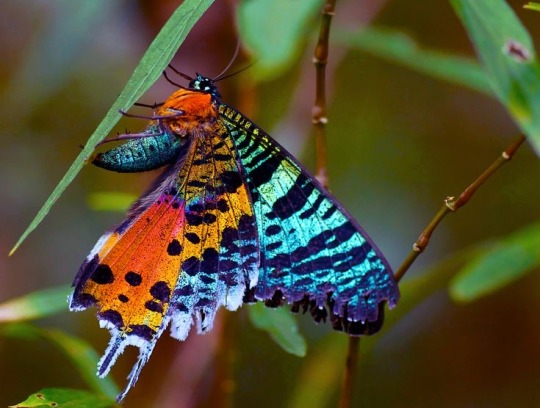
The Madagascan sunset moth is in the family Uraniidae. This species was first described in 1773 by Dru Drury who put it in the Papilio genus, a genus of butterflies. He though this because it looked like a swallowtail butterfly, and additionally the specimen he was given had a different species’s head with clubbed antennae (a defining characteristic of butterflies) attached to the body. Jacob Hübner corrected this mistake in 1823 and placed the moth in the genus Chrysiridia. I though this moth would be perfect to post in June for its rainbow colors.
Description The Madagascan sunset moth’s body are covered in black fur on the back and orange fur on the underside. The thorax is an iridescent blue or green and the legs and head are black with filiform antennae. The wings are iridescent red, blue, and green with the colors mixing for the full rainbow. Black patterning of spots and stripes are on all four wings with the forewings having a black edge. The hindwings themselves have a white fringe on the edge and six tails which are often broken off or damaged over time. The upper side of both wings are mostly black with a large patch by the body. Patterns on the wings can vary and some moths are asymmetrical. This can be caused by many things like temperature shock during growth.
The colors on this moth’s wings do not come from pigments, but instead are caused by the scattering of light from the wings’ scales.
Average wingspan in high altitudes: 7 cm (≈2.8 in)
Average wingspan in low altitudes: 9 cm (≈3.5 in)
On occasion a moth’s wingspan can be as large as 11 cm (≈4.3 in).
Diet and Habitat The larva feed on four types of plants from the Omphalea genus that grow only on Madagascar. These species are O. ankaranensis, O. palmata, O. occidentalis, and O. oppositifolia. The larva eat all parts of the plants from leaves, to stems, to flowers, to fruits, but they avoid the veins of the leave which have a toxic latex in them. Adult moths drink nectar and prefer white or whitish-yellow flowers especially from the Indian almond tree, tea plant, loquat, plants in the Eucalyptus genus, and common mango tree.
First believed to have come from China or Bengal, this moth is only found in Madagascar. They migrate over the island to different areas with their host plant and can be found all over the island except for the south west and extreme south where their host does not grow. This moth’s preferred habitats are deciduous forests and rain forest regions.
Mating These moths mate all year but have the highest populations in March to August and the lowest populations in October to December. The females lay their eggs late in the afternoon or at nightfall. The females will usually lay the eggs in the underside of the host plant’s leaves in groups but can on occasion lay them on top.
Average number of eggs laid in each group: 80 eggs
Predators The Omphalea genus the caterpillars feed on also attracts polistine wasps who prey on the larva. However, the caterpillars and adult moths are toxic because the Omphalea species contains polyhydroxy alkaloids, which the caterpillars gain by eating and retain as adult moths. The wings’ bring colors are a warning signal of this.
Fun Fact The Malagasy people believe the souls of the dead or of ancestors appears in the form of a lepidopteran. The Madagascan sunset moth is specifically called adriandolo or lolonandriana, from lolo for "spirit" or "butterfly" and andriana for "noble" or "king.”
Additionally, eating the silk from this moth is said to cause a euphoric high.
Another interesting fact is the Madagascan sunset moth is one of only two species in the Chrysiridia genus.
(Source: Wikipedia, Moth Identification, Bug Under Glass)
#animals#bugs#facts#insects#libraryofmoths#moth#mothoftheweek#lepidoptera#Chrysiridia rhipheus#Madagascan sunset moth#Uraniidae#pride month#rainbow
169 notes
·
View notes
Text
Moth of the Week
Peppered Moth
Biston betularia

The peppered moth is a part of the family geometridae. It was first described in 1758 by Charles Linnaeus. This moth gains its name from its speckled coloration, which has been studied as an example of natural selection and population evolution.
Description This species has a short body with narrow forewings. The body and wings are the same white base peppered with black dots and irregular black lines. This speckled pattern may vary with some moths having very few spots and others having so many that they look as if they are black with white spots as opposed to white with black. In rare cases, the black on the wings and body is replaced with gray or brown and in even rarer cases the spots are a combination of brown and black/gray. These spots help the moth camouflage against lichen on trees.
The evolution of this moth had been studied extensively during the last two hundred years, which created the term “industrial melanism.” During the Industrial Revolution, air pollution killed off lichen and covered trees in soot. This caused moths with a black spots on white base (typica) coloration to lose their camouflage and die off due to predators. This caused a spike in population for moths with a darker coloration (carbonaria) because they had the camouflage advantage. Once environmental conditions improved, the lighter colored moths once again became the dominant coloration.
The male’s antennae are bipectinate, meaning it has two rows of rami going down either side of a singular flagellum.
Wingspan Range: 45 - 62 mm (≈1.77 - 2.44 in)
Diet and Habitat The caterpillar of this moth eats many trees, shrubs, and small plants such as Blackthorn (Prunus spinosa), Hawthorn (Crataegus monogyna), Downy (Betula pubescens) and Silver Birch (Betula pendula), limes, sallows, poplars, oaks, Sweet Chestnut (Castanae sativa), Beech (Fagus sylvatica), Bramble (Rubus fruiticosus), Broom (Cytisus scoparius), Black Currant (Ribes nigrum) and Hop (Humulus lupulus).
They have a wide range, being found in China (Heilongjiang, Jilin, Inner Mongolia, Beijing, Hebei, Shanxi, Shandong, Henan, Shaanxi, Ningxia, Gansu, Qinghai, Xinjiang, Fujian, Sichuan, Yunnan, Tibet), Russia, Mongolia, Japan, North Korea, South Korea, Nepal, Kazakhstan, Kyrgyzstan, Turkmenistan, Georgia, Azerbaijan, Armenia, Europe and North America. They prefer habitats of woodland, scrub, hedgerows, parks and gardens.
Mating Depending on its location, this moth can have one or two generations per year. In Great Britain and Ireland, the peppered moth has one generation per year, whilst in south-eastern North America it has two generations per year. They emerge from the pupea in late May to August.
The females attract males with pheromones, which are carried by the wind. Males follow the concentration gradient to find the female. The male guards the female from other males until she lays the eggs. The female lays about 2,000 pale-green ovoid eggs about 1 mm in length into crevices in bark with her ovipositor.
Predators This species is a night-flying moth, making the vulnerable to bats. The males in particular fly every night to search for a female while females fly only the first night.
To protect themselves from birds during the day, this species rests on lichen covered trees to camouflage themselves.
The day time resting positions of this moth have been recorded and studied. This study shows that the peppered moth prefers resting spots that are covered such as below where the trunk and a branch meet, the underside of branches, and leafy twigs.
Additionally, the study found peppered moths with a lighter coloration (typica) blend in better against crustose lichens rather than foliose lichens because birds can see ultraviolet light. The peppered moth reflects UV light while crustose lichens don’t, making them easier to pick out.
Fun Fact The caterpillars of the peppered moth resemble things in both color and size. An experiment published in 2019 done on the caterpillars of the peppered moth showed that the larva (even when blindfolded) could sense the color of the tree they live on and change their body color to match and/or would move to a different twig that was closest in color to their own body.
(Source: Wikipedia, Butterfly Conservation, Max Planck Institute)
#Biston betularia#libraryofmoths#animals#bugs#facts#insects#moth#lepidoptera#mothoftheweek#Geometridae#peppered moth
84 notes
·
View notes